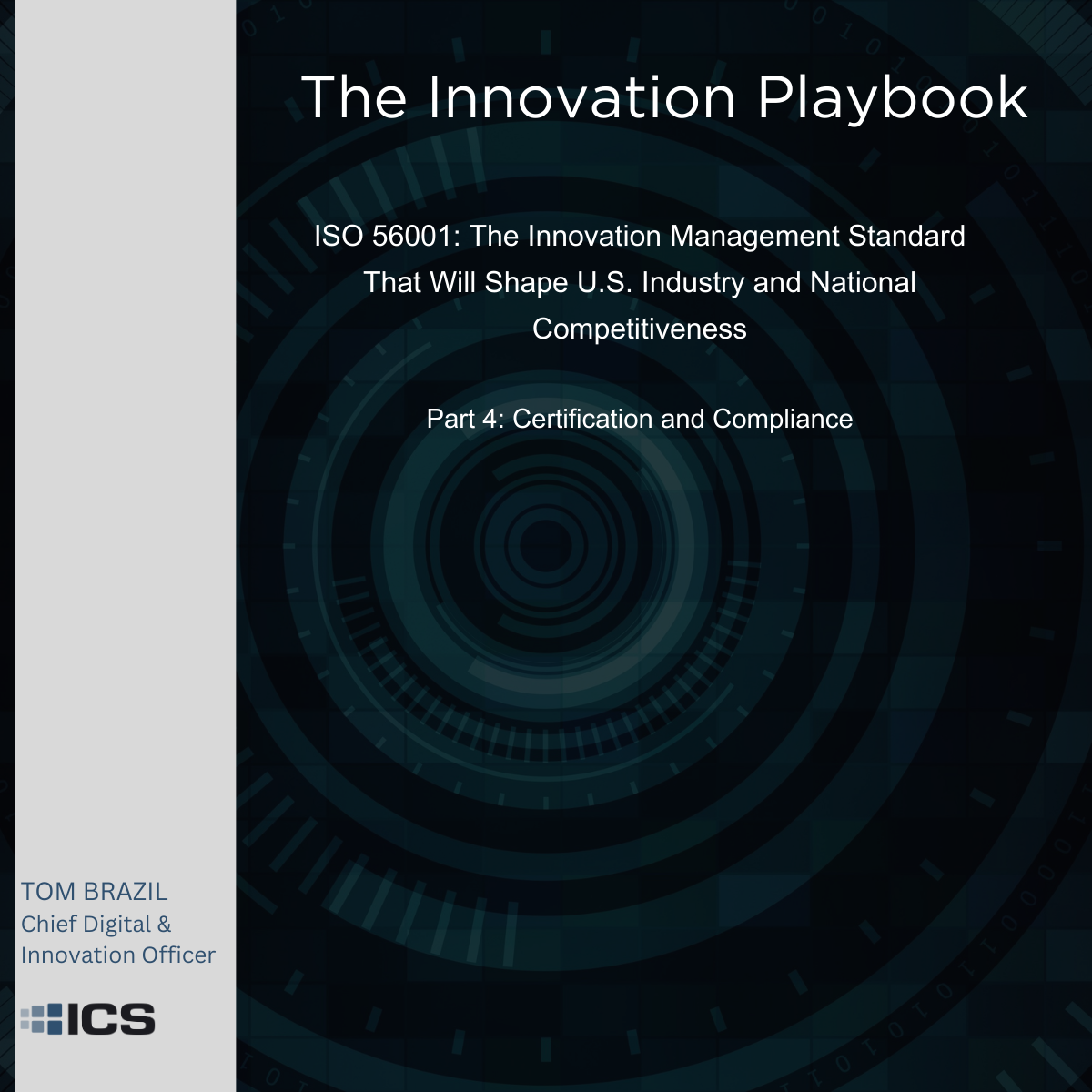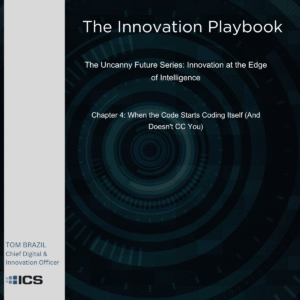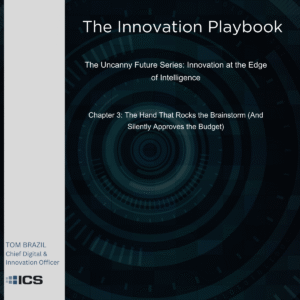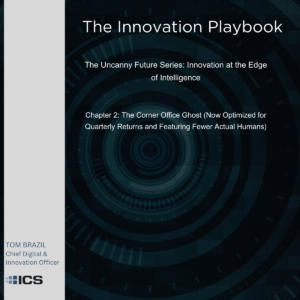In previous discussions, we explored the fundamentals of ISO 56001, its core components, and the steps organizations can take to implement it successfully. By now, the picture is clear: Innovation must be managed strategically, measured rigorously, and continuously improved. But, for businesses and government agencies looking to fully commit to structured innovation, a key question arises:
What does certification look like, and how can organizations ensure compliance with ISO 56001?
Certification is more than a seal of approval—it’s a powerful signal of innovation maturity. Much like ISO 9001 transformed quality management, ISO 56001 is set to define innovation excellence worldwide. For organizations in defense, aerospace, technology, and other critical industries, certification could soon become a requirement for contracts, funding, and partnerships.
In this installment, we break down the ISO 56001 certification process, key compliance criteria, and how this standard integrates with other ISO frameworks like ISO 9001 and ISO 27001.
Is ISO 56001 a Certifiable Standard?
Yes. Unlike ISO 56002, which provides guidelines, ISO 56001 establishes mandatory requirements that organizations must meet to obtain certification. This means companies can undergo an external audit to demonstrate their ability to systematically manage innovation, assess risks, and measure outcomes.
For industries where compliance with innovation frameworks is becoming a global standard—such as aerospace, defense, and financial services—ISO 56001 certification will become a strategic advantage. Just as ISO 9001 certification helps companies qualify for contracts by proving quality assurance, ISO 56001 certification will serve as validation that an organization has a structured, repeatable approach to innovation.
What Is the Certification Process?
Becoming ISO 56001-certified is not an overnight process—it requires a deliberate, phased approach to aligning innovation management with the standard’s requirements. Organizations should expect to move through the following key stages:
1. Preparation and Internal Assessment
Before engaging an external certifying body, organizations should conduct an internal audit to assess their current innovation management system. Leadership should ask:
- Do we have an established innovation policy that aligns with business strategy?
- Are innovation roles and responsibilities clearly defined?
- Do we track and measure innovation performance using standardized KPIs?
This phase is crucial for identifying gaps and making preliminary adjustments before a formal certification audit. If needed, many Innovation Management Systems Professionals are available to help you on your journey (www.imsprofessionals.com).
2. Implementation and Documentation
ISO 56001 requires documented processes for innovation governance, risk management, and performance tracking. Organizations must:
- Develop a formalized innovation strategy and policy framework.
- Establish clear governance structures, ensuring leadership is accountable for innovation outcomes.
- Implement a structured system for generating, validating, and scaling new ideas.
- Define KPIs to measure innovation success, such as time-to-market and revenue from new initiatives.
Documentation is critical here—not only does it ensure compliance, but it also creates a sustainable blueprint for innovation management.
3. External Audit and Certification
Once the internal framework is in place, an ISO-accredited certification body will conduct a two-stage audit:
- Stage 1: A review of innovation policies, governance structures, and readiness for certification.
- Stage 2: A full assessment of how innovation processes are implemented, measured, and continuously improved.
If nonconformities are found, the organization will be given time to address deficiencies before certification is granted.
4. Ongoing Compliance and Surveillance Audits
Certification is valid for three years, but annual surveillance audits are required to ensure the organization continues to meet ISO 56001 standards and adapts to new innovation challenges. Organizations must:
- Regularly review innovation performance and adapt strategies accordingly.
- Conduct internal audits to identify areas for improvement.
- Maintain compliance with evolving industry standards and regulations.
ISO 56001 is not a one-time achievement—it’s a commitment to continuous innovation excellence.
What Are the Key Criteria for Certification?
To become ISO 56001-certified, organizations must meet a set of core requirements:
1. Leadership Commitment and Strategic Integration
Innovation cannot be an isolated effort within R&D or a side project for a single department. ISO 56001 requires leadership to take full ownership of innovation as a strategic function.
- Executives must integrate innovation into corporate strategy and decision-making.
- An Innovation Policy must be formally established.
- Resources—including funding, personnel, and technology—must be allocated to innovation efforts.
2. Governance and Risk Management
Innovation is inherently uncertain, but ISO 56001 ensures that organizations manage risks proactively.
- Companies must have a structured framework for identifying and mitigating innovation risks.
- Decision-making processes for evaluating, prioritizing, and approving innovation projects must be clearly defined.
3. Systematic Innovation Process
Organizations must demonstrate a structured, repeatable process for innovation, including:
- Opportunity identification through market research and technology scouting.
- Idea generation and validation using data-driven decision-making.
- Development and scaling through iterative experimentation.
- Performance evaluation and continuous improvement based on KPIs.
4. Performance Measurement and Continuous Improvement
Certified organizations must establish quantifiable innovation metrics to track their progress:
- Time-to-market for new innovations.
- ROI on R&D investments.
- Success rate of new product launches or process innovations.
Certification isn’t just about passing an audit—it’s about building a long-term system that ensures innovation efforts deliver measurable results.
How Does ISO 56001 Integrate with Other ISO Standards?
For organizations already certified in other ISO management systems, implementing ISO 56001 is a natural extension. It shares a common high-level structure (HLS) with:
- ISO 9001 (Quality Management) – Ensures that innovation efforts align with quality assurance processes.
- ISO 27001 (Information Security) – Helps organizations protect intellectual property and cybersecurity risks in innovation.
- ISO 14001 (Environmental Management) – Supports sustainability-driven innovation and green technology development.
This means companies can integrate ISO 56001 into existing compliance structures, streamlining audits and governance. For example, a defense contractor managing both ISO 27001 (cybersecurity) and ISO 56001 (innovation management) can ensure that R&D efforts remain both secure and strategically aligned.
The Growing Importance of Certification
Globally, countries like Germany, China, and South Korea are already embedding ISO 56001 principles into their innovation ecosystems. The EU’s Horizon Europe program, for instance, encourages structured innovation management in tech and sustainability projects.
For the U.S. government, DoD, and major industries, ISO 56001 certification could soon become a competitive differentiator. Organizations that achieve certification will:
- Be more attractive for government contracts and federal innovation grants.
- Gain an advantage in global supply chains, as partners and investors look for structured innovation processes.
- Reduce risks and increase efficiency in new technology development and commercialization.
- As DOGE continues to cut spending, proving you are using innovation spend efficiently would be a strength in government proposals
The question isn’t whether ISO 56001 will become the new global standard for innovation management, it’s how soon organizations will adopt it to stay competitive.
What’s Next? Leadership and Business Strategy
Now that we’ve covered certification and compliance, the next step is understanding:
- How ISO 56001 fosters a culture of innovation.
- The role of leadership in driving structured innovation.
- How organizations can measure and track innovation performance effectively.
That’s exactly what we’ll explore in Part 5: Innovation and Business Strategy next week.
Are You Ready for ISO 56001 Certification?
How do you see ISO 56001 shaping your organization’s innovation future? Let’s discuss in the comments!
Follow this series for insights on how ISO 56001 will impact U.S. industry and national competitiveness.







